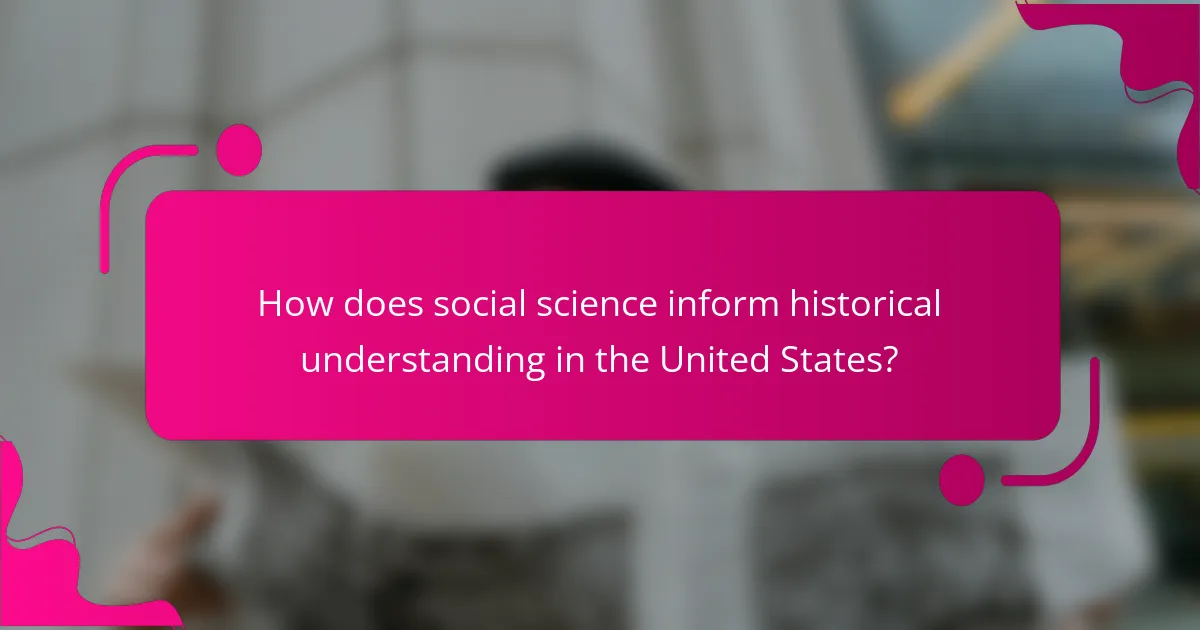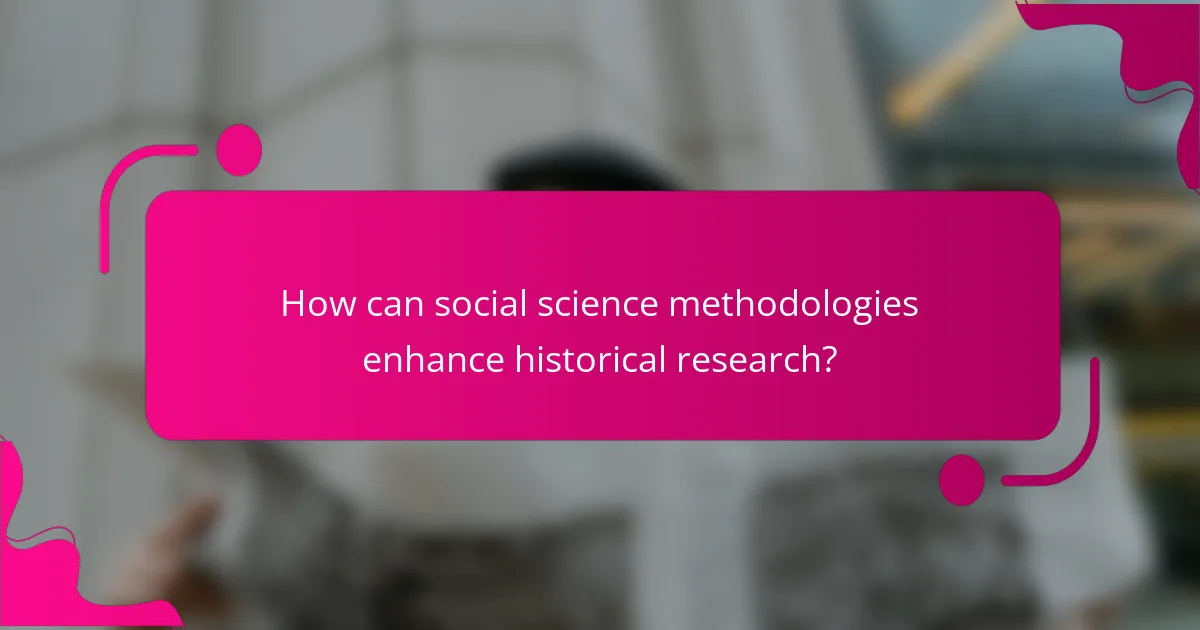Social science plays a crucial role in enhancing our understanding of history by providing analytical frameworks that explore human behavior and societal trends. By employing various methodologies, such as quantitative and qualitative analysis, social scientists help historians interpret events within the broader context of social dynamics. This interdisciplinary approach allows for a more nuanced understanding of how historical events are influenced by underlying societal structures and interactions.

How does social science inform historical understanding in the United States?
Social science enhances historical understanding in the United States by providing frameworks and methodologies to analyze human behavior, societal trends, and cultural contexts. This interdisciplinary approach allows historians to interpret events not just as isolated incidents, but as part of broader social dynamics.
Interdisciplinary approaches
Interdisciplinary approaches combine insights from various fields such as sociology, psychology, and anthropology to enrich historical analysis. By integrating these perspectives, researchers can explore the motivations behind historical events and the societal structures that influenced them.
For example, examining the Civil Rights Movement through a sociological lens reveals how social networks and community organizing played crucial roles in mobilizing support and effecting change. This multifaceted view helps to create a more nuanced understanding of historical narratives.
Case studies in American history
Case studies in American history illustrate how social science methodologies can uncover deeper insights. The study of immigration patterns, for instance, can highlight the economic and social factors that shaped policies and public perception over time.
Analyzing the Great Migration through both historical and sociological lenses shows how African Americans moved from rural South to urban North, driven by economic opportunities and escaping systemic racism. Such case studies provide concrete examples of how social science informs our understanding of historical events.
Impact on public policy
Social science research significantly impacts public policy by informing lawmakers about the social implications of their decisions. Understanding historical contexts helps policymakers anticipate the effects of legislation on different communities.
For instance, studies on poverty and education have led to reforms aimed at addressing systemic inequalities in the U.S. education system. By grounding policy decisions in social science findings, legislators can create more effective and equitable solutions that reflect the needs of the population.

What are the key social science theories relevant to historical context?
Key social science theories that relate to historical context include structural functionalism, conflict theory, and symbolic interactionism. Each of these theories offers a distinct perspective on how societal structures and interactions shape historical events and contexts.
Structural functionalism
Structural functionalism posits that society is made up of various institutions and structures that work together to maintain stability and order. This theory emphasizes the importance of each part of society, such as family, education, and religion, in contributing to the overall functioning of the social system.
For example, in historical contexts, the role of the family unit in maintaining social norms can be seen in various cultures. Understanding these functions helps to analyze how societal changes, such as industrialization, impact family structures and roles.
Conflict theory
Conflict theory focuses on the struggles between different social classes and groups, highlighting how power dynamics shape historical events. This perspective argues that societal change often arises from conflicts over resources, rights, and power, leading to social transformation.
For instance, the labor movements of the early 20th century illustrate conflict theory, as workers organized to challenge the power of industrialists. Analyzing these conflicts provides insight into how economic disparities influence historical developments.
Symbolic interactionism
Symbolic interactionism examines the meanings and interpretations individuals assign to social interactions and symbols. This theory emphasizes the subjective nature of social reality, suggesting that historical events are shaped by the way people perceive and react to them.
For example, the civil rights movement in the United States can be understood through the lens of symbolic interactionism by analyzing how symbols like protests and speeches influenced public perception and social change. This approach highlights the importance of individual agency in shaping history.

How do social sciences analyze historical events?
Social sciences analyze historical events by employing various methodologies that help to interpret and understand the complexities of past occurrences. These methods include quantitative analysis, qualitative research, and comparative analysis, each offering unique insights into how historical contexts shape societal dynamics.
Quantitative methods
Quantitative methods in social sciences involve the use of statistical techniques to analyze numerical data related to historical events. Researchers often gather data from surveys, censuses, or historical records to identify patterns and trends over time.
For example, a researcher might analyze census data to understand demographic shifts during a specific historical period, such as migration patterns during the Industrial Revolution. This approach allows for the identification of correlations and causal relationships, often represented through graphs and charts.
Qualitative research
Qualitative research focuses on understanding the meanings and experiences behind historical events through non-numerical data. This method often includes interviews, focus groups, and content analysis of historical documents, providing deeper insights into the social and cultural contexts of the time.
For instance, analyzing letters or diaries from a specific era can reveal personal perspectives and societal attitudes that quantitative data may overlook. This approach emphasizes the richness of human experience and the subjective interpretation of historical events.
Comparative analysis
Comparative analysis involves examining different historical events or societies to identify similarities and differences that can inform understanding of broader social phenomena. This method can help researchers draw lessons from past events and apply them to contemporary issues.
For example, comparing the civil rights movements in the United States and South Africa can highlight different strategies and outcomes, providing valuable insights into social change. This approach encourages critical thinking about how historical contexts influence societal structures and relationships.

What role does context play in social science research?
Context is crucial in social science research as it shapes the understanding of social phenomena. Researchers must consider historical, cultural, and geographical factors to accurately interpret data and draw meaningful conclusions.
Historical context
Historical context refers to the time period in which a social phenomenon occurs, influencing its development and significance. Understanding past events, societal changes, and historical narratives can provide insights into current social dynamics.
For example, examining the civil rights movement in the United States requires knowledge of the legal and social conditions of the 1960s. This historical lens helps researchers grasp the movement’s impact on contemporary social justice issues.
Cultural context
Cultural context encompasses the beliefs, values, and practices of a society that shape individual and group behaviors. It is essential for interpreting social interactions and understanding how cultural norms influence research outcomes.
For instance, studying family structures in different cultures reveals variations in roles and responsibilities. Researchers must be aware of these cultural differences to avoid biases and misinterpretations.
Geographical context
Geographical context involves the physical location and environment where social phenomena occur. Factors such as climate, urban versus rural settings, and regional resources can significantly affect social behaviors and relationships.
For example, access to education and healthcare often varies between urban and rural areas, impacting social mobility and health outcomes. Researchers should consider these geographical disparities when analyzing data to ensure accurate conclusions.

How can social science methodologies enhance historical research?
Social science methodologies can significantly enhance historical research by providing diverse analytical frameworks and tools that allow for a more nuanced understanding of past events. These methodologies enable historians to incorporate quantitative data and qualitative insights, leading to richer interpretations of historical contexts.
Mixed methods approach
A mixed methods approach combines qualitative and quantitative research techniques, allowing historians to explore complex questions from multiple angles. For instance, a historian might analyze statistical data on population changes while also conducting interviews with community members to understand the social impacts of those changes.
This approach can reveal patterns that purely qualitative or quantitative methods might miss, providing a more comprehensive view of historical phenomena. However, researchers should ensure that both methods are well-integrated to avoid conflicting conclusions.
Data triangulation
Data triangulation involves using multiple data sources to validate findings, enhancing the credibility of historical research. By cross-referencing archival documents, oral histories, and archaeological evidence, historians can build a more robust narrative of past events.
For example, if a historian is studying a specific event, they might compare government records with newspaper articles and personal letters. This method helps to identify biases and fill in gaps, leading to a more balanced understanding of history.
Longitudinal studies
Longitudinal studies track changes over time, providing insights into historical trends and developments. By examining data from various periods, historians can identify long-term patterns and shifts in societal attitudes or behaviors.
For example, a longitudinal study on educational attainment might reveal how access to education has evolved over decades in a specific region. This approach allows researchers to understand the implications of historical events on contemporary issues, making it a valuable tool in social science and historical research.
